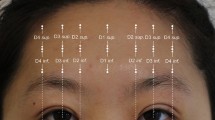Abstract
Background: Patient satisfaction is the most important outcome in facial aesthetic surgery. However, the need for evidence-based evaluation of aesthetic procedures dictates the use of more objective and quantitative measures of treatment outcome.
Objective: The present study was undertaken to validate a new clinical outcome instrument, the Wrinkle Severity Rating Scale.
Methods: Five clinical investigators were presented with 30 photographic images of the lower face and asked to rate nasolabial fold severity on each side using the 5-grade Wrinkle Severity Rating Scale (WSRS). Standardized definitions of the five grades were provided to the investigators in visual (photographic) and descriptive formats. To take into account possible facial asymmetry, nasolabial folds on the left and right sides of the face were rated separately. Assessments were conducted independently and were repeated after ≥2 weeks.
Results: Intra-observer (test-retest) agreement was 68.7% (left side) and 72.7% (right side); weighted kappa coefficients for the left and right sides were 0.77 and 0.81, respectively. Mean inter-observer agreement (internal consistency) was 67.7% (left side) and 72.3% (right side); weighted kappa coefficients for the left and right sides were 0.75 (95% CI 0.70–0.79) and 0.78 (95% CI 0.72–0.83), respectively.
Conclusion: The WSRS is a valid and reliable instrument for quantitative assessment of facial skin folds, with good inter- and intra-observer consistency. By allowing objective and reproducible grading of data, the WSRS should prove a useful clinical tool for assessing the effectiveness of soft-tissue augmentation and other facial contouring procedures.





Similar content being viewed by others
References
Most SP, Alsarraf R, Larrabee WF. Outcomes of facial cosmetic procedures. Facial Plast Surg 2002; 18: 119–24
Luce EA. Outcome studies and practice guidelines in plastic surgery. Plast Reconstr Surg 1999; 104: 1187–90
Lemperle G, Holmes RE, Cohen SR, et al. A classification of facial wrinkles. Plast Reconstr Surg 2001; 108: 1735–50
Gormley DE, Wortzman MS. Objective evaluation of methods used to treat cutaneous wrinkles. Clin Dermatol 1988; 6: 15–23
Grove GL, Grove MJ, Leyden JJ. Optical profilometry: an objective method for quantification of facial wrinkles. J Am Acad Dermatol 1989; 21: 631–7
Grover R, Grobbelaar AO, Morgan BDG, et al. A quantitative method for the assessment of facial rejuvenation: a prospective study investigating the carbon dioxide laser. Br J Plast Surg 1998; 51: 8–13
Griffiths CEM, Wang TS, Hamilton TA, et al. A photonumeric scale for assessment of cutaneous photodamage. Arch Dermatol 1992; 128: 347–51
Fleiss JL. Statistical methods for rates and proportions. Hoboken (NJ): John Wiley & Sons, 1981
Lagarde JM, Rouvrais C, Black D, et al. Skin topography measurement by interference fringe projection: a technical validation. Skin Res Technol 2001; 7: 112–21
Narins R, Brandt F, Leyden J, et al. A randomised, double-blind, multicenter comparison of the efficacy and tolerability of Restylane versus Zyplast for the correction of nasolabial folds. Dermatol Surg 2003; 29: 588–95
Acknowledgements
This study was supported by Q-Med AB, Uppsala, Sweden. We thank Dr Andrew Frankel, MD (Division of Head and Neck Surgery, University of California at Los Angeles, CA, USA) for his contribution as an investigator in the study. The authors have no conflicts of interest that are directly relevant to the content of this manuscript.
Author information
Authors and Affiliations
Rights and permissions
About this article
Cite this article
Day, D.J., Littler, C.M., Swift, R.W. et al. The Wrinkle Severity Rating Scale. Am J Clin Dermatol 5, 49–52 (2004). https://doi.org/10.2165/00128071-200405010-00007
Published:
Issue Date:
DOI: https://doi.org/10.2165/00128071-200405010-00007




